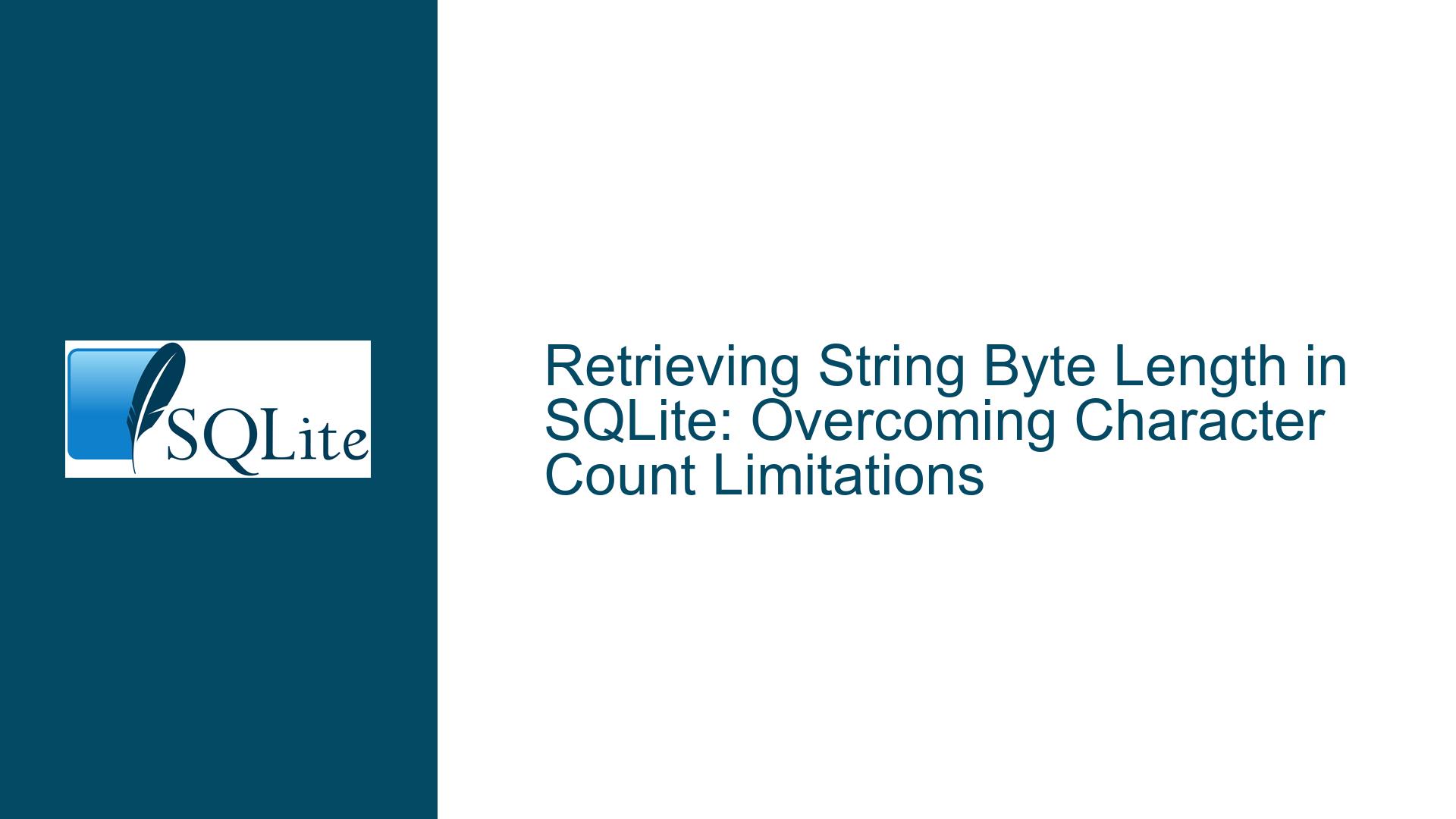Retrieving String Byte Length in SQLite: Overcoming Character Count Limitations
Character Storage Semantics: Why SQLite’s LENGTH() Returns Character Counts Instead of Byte Sizes
Issue Overview: Discrepancy Between Character Count and Byte Length for UTF-8 Strings
SQLite’s LENGTH() function returns the number of characters in text values, but this behavior becomes problematic when developers need to determine the actual storage size of strings in bytes. This discrepancy arises from SQLite’s handling of text encoding and its type system. Text strings are stored using variable-width encodings like UTF-8, where individual characters may occupy 1–4 bytes. For example, the string ‘é’ contains one Unicode character (U+00E9) but requires 2 bytes in UTF-8 (0xC3 0xA9). The LENGTH() function counts each Unicode code point as a single character, ignoring the underlying byte storage requirements. This creates confusion when calculating storage limits, network transmission payloads, or binary compatibility with external systems expecting fixed-width encodings.
The problem is compounded by SQLite’s dynamic typing system, where column types are mere hints rather than rigid constraints. When a string is stored in a BLOB column or cast to a BLOB type, SQLite treats it as a raw sequence of bytes. The same LENGTH() function applied to BLOBs returns byte counts instead of character counts, creating an inconsistency that developers must explicitly manage. This dual behavior is not inherently documented in the core function descriptions, leading to frequent misunderstandings.
Underlying Mechanisms: How Encoding, Normalization, and Type Casting Affect Length Calculations
Possible Causes: UTF-8 Encoding Complexity and Implicit Type Conversions
Variable-Width UTF-8 Encoding
UTF-8 encoding uses 1–4 bytes per character, with ASCII characters (U+0000–U+007F) occupying 1 byte and higher code points using multiple bytes. The LENGTH() function’s character-centric counting ignores this variability, leading to underestimation of storage requirements for strings containing non-ASCII characters. For instance, the string ‘açé’ contains 3 characters but requires 5 bytes (1 + 2 + 2) in UTF-8.
Unicode Normalization Forms
Strings that appear identical visually may have different byte representations due to Unicode normalization. Precomposed characters (e.g., ‘é’ U+00E9) and decomposed sequences (e.g., ‘e’ U+0065 + combining acute accent U+0301) are treated as distinct by LENGTH(), even though they render identically. The precomposed ‘é’ is 1 character (2 bytes), while the decomposed ‘é’ is 2 characters (3 bytes: 1 for ‘e’ and 2 for the combining accent).
SQLite Type Affinity and Casting Behavior
SQLite’s type affinity system does not enforce strict type checking. When a string is cast to a BLOB using CAST(x AS BLOB), the operation reinterprets the text’s UTF-8 bytes as a raw binary object without altering the data. This allows LENGTH(CAST(x AS BLOB)) to return the byte count, but the behavior is non-obvious to those unfamiliar with SQLite’s type conversion rules.
Resolving the Discrepancy: Techniques for Accurate Byte Length Determination
Troubleshooting Steps: Converting Text to BLOB and Handling Edge Cases
Step 1: Cast Text to BLOB for Byte Length
To obtain the byte length of a text string, explicitly cast it to a BLOB before applying LENGTH():
SELECT LENGTH(CAST('YourString' AS BLOB)) AS byte_length;
This works because casting to BLOB preserves the original UTF-8 byte sequence, and LENGTH() returns the number of bytes for BLOB values.
Example Analysis:
SELECT LENGTH('dayé') AS char_length, -- Returns 4
LENGTH(CAST('dayé' AS BLOB)) AS byte_length; -- Returns 5 (d=1, a=1, y=1, é=2)
Step 2: Account for Unicode Normalization
Strings containing decomposed characters will yield higher byte counts than their precomposed equivalents. Use the NORMALIZE function (available with the ICU extension) to standardize strings before measurement:
SELECT LENGTH(CAST(NORMALIZE('é') AS BLOB)) AS normalized_byte_length; -- Returns 3 (e + combining accent)
Without normalization, the same string might be stored in multiple byte forms, leading to inconsistent length measurements.
Step 3: Handle BOM and Encoding-Specific Artifacts
UTF-8 encoded text may include a Byte Order Mark (BOM), though this is uncommon. If present, the BOM (0xEFBBBF) adds 3 bytes to the blob length. Explicitly remove it if necessary:
SELECT LENGTH(CAST(TRIM(CHAR(0xef, 0xbb, 0xbf) || 'String') AS BLOB));
Step 4: Validate Encoding Consistency
Ensure all text is consistently encoded in UTF-8. Mixed encodings (e.g., UTF-8 and Latin-1) within the same string will produce incorrect byte counts. Use SQLite’s HEX() function to inspect byte patterns:
SELECT HEX(CAST('é' AS BLOB)); -- Returns 'C3A9' (valid UTF-8)
Step 5: Consider Alternative Approaches for Specialized Use Cases
For environments without access to the CAST function or requiring additional validation, use auxiliary functions:
- Hexadecimal Conversion: Calculate byte length by dividing the length of the hex string by 2:
SELECT LENGTH(HEX(CAST('é' AS BLOB))) / 2 AS byte_length; -- (4 / 2 = 2) - User-Defined Functions (UDFs): Extend SQLite with a custom
BYTE_LENGTH()function using thesqlite3_create_function()API to handle edge cases like invalid UTF-8 sequences.
Step 6: Address Collation and Comparison Side Effects
When using BLOB casts in comparisons, note that BLOB collation is binary, whereas text uses locale-aware rules. This can affect queries where byte length calculations are part of conditional logic:
SELECT * FROM table
WHERE LENGTH(CAST(text_column AS BLOB)) BETWEEN 10 AND 20;
Key Takeaways and Best Practices
- Explicit Casting: Always use
CAST(x AS BLOB)when byte length is required. - Normalize Unicode: Apply normalization if visual consistency affects length requirements.
- Inspect Byte Patterns: Use
HEX()to debug unexpected length results. - Document Assumptions: Clearly state whether character counts or byte lengths are being used in schema definitions and application logic.
By understanding SQLite’s type system and encoding behavior, developers can reliably bridge the gap between character counts and byte lengths, ensuring accurate data handling in all scenarios.






